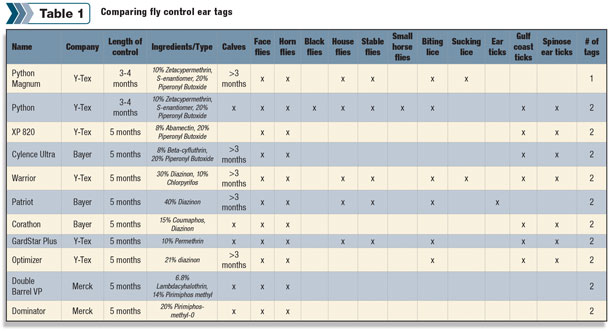
Two main classes exist – pyrethrins and organophosphates – that producers need to be rotating between to avoid creating resistance.
“It’s not that there’s a ton of resistance out there just yet that I’m aware of, but the problem lies in your operation if you use the same ear tag year after year after year, you get the same class,” Daly says.
Most veterinarians recommend switching what type is used on an operation every year. Producers going into their veterinarian’s office can find out what type of tag they used last year if they bought them there.
Daly says if producers buy their fly tags from a farm store, they are relying on their own memory of what they think they used last year rather than the records on file at the vet office.
He also pointed out that even if producers switch fly tag brands every year, they could actually still be using the same insecticide.
“If you switch to a different brand name, it could be the same class of chemical you used last year, so you would actually not be rotating,” Daly says. “Even though it’s a different tag, you’re still using the same thing as last year when it comes to the active ingredient.”
Daly says both classes of chemical are effective at repelling the flies that cause the most issues for cattle – horn flies and face flies. Most labels say two tags in a cow’s ears will retain their effectiveness for up to five months. Daly says in most cases that effectiveness in the fifth month is pretty low.
Click here or on the image above to view it at full size in a new window (PDF 2.0MB)
Oftentimes the recommendation is to wait to put the fly tags in until after the flies are already out.
“If you think about it, the minute you take that tag out of the bag it starts losing its effectiveness. The insecticide is being used up,” Daly says. “The best bang for your buck of course is waiting until there’s a threshold of flies on the animals already, but from my experience that’s kind of a secondary thing.
“It’s more of a ‘when can we get the tag on the animal?’ It’s going to be going out to summer pasture, assuming that’s going to be May or June for us (in South Dakota).
It’s probably not a bad time to do it, but waiting until a little bit later would be the best bang for the buck when it comes to using those tags, but I sure realize that’s not always possible,” he says.
Daly says it is difficult to measure the effectiveness of fly tags in the real world because every operation is different, climates differ all over the country, fly loads differ, and moisture plays a role. In addition to fly tags, he suggests producers think about fly control using different modes of action.
“We always recommend that people think about fly control in terms of more of a multi-pronged attack, so not just the back rub or not just the pour-ons and stuff like that,” Daly says. “In real bad years, we’re going to have to use more than one intervention to help those animals from being affected so badly.”
When it comes to using fly tags, Daly says producers need to be diligent in how they use them and how they dispose of them. When applying the tags, producers should wear rubber gloves. When discarding, follow label directions for proper and safe disposal.
“When the calves are coming in for their weaning shots, take those fly tags out because there might be some of that chemical left, not enough to really do much for overall fly relief but enough to maybe elicit some resistance in some of the flies that are still around. It’s always good to get rid of them,” Daly says. ![]()
Wendy Sweeter is a freelance writer based in South Dakota.







